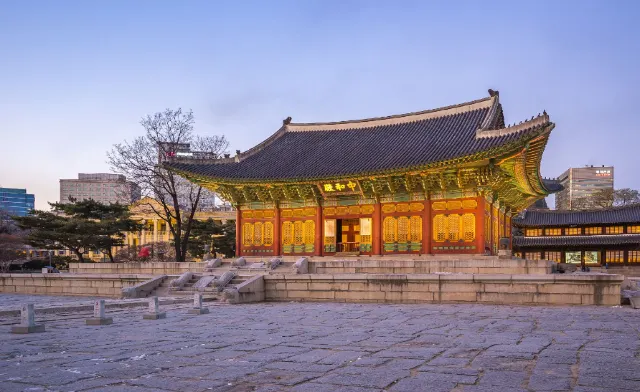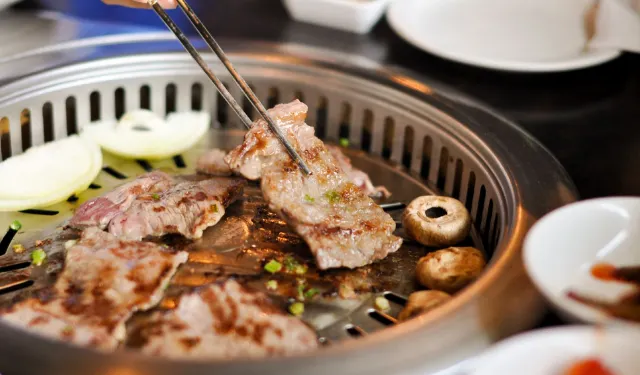Seoul Travel Guide 2022
Catalogue
- Things to know if you're visiting Seoul for the first time
- How To Get To Seoul by Flights
- Transportation in Seoul
- Best Time to Visit Seoul
- 3 Must-Visit Attractions in Seoul
- Seoul Food: What to Eat in Korea
- Shopping in Seoul
- Local Customs in Seoul
Show More
With its cutting-edge coolness and deep-rooted traditions, South Korea’s capital Seoul rivals other major Asian cities in culture, innovation, and as being one of the top tourist destinations in the region.
Situated in the northwest of South Korea, Seoul developed into a megacity on the banks of the Han River. As the largest city in the country, it is also one of East Asia's most important cultural and financial centers. The capital has a population of nearly 10 million people that provides the workforce for the 17th richest cities in the world by GDP (in 2020). There are 25 districts where Jung-gu is the central district, Seocho-gu is ranked as the second richest district in South Korea, and Gangnam-gu is known for its concentrated wealth and very high standard of living.
While today Seoul is the cultural, economic, and political center of South Korea, it had been the capital of Korea from 1394 until the formal division of the country into North (Democratic People's Republic of Korea) and South Korea (the Republic of Korea) in 1948. In fact, the name Seoul means “capital” in the Korean language. The size of the capital has expanded dramatically in recent decades, now the northwestern edge lies only about 40 km (25 miles) from the demilitarized zone that divides North and South Korea.
There are so many first-rate scenic spots on offer in Seoul and it is impossible to see them all if you only have a few days. Attractions in the city have a perfect mix of modern and ancient, tranquil and vibrant, well suited for tourists of all ages. Make sure you admire the amazing architectural design of the Gyeongbokgung Palace, chill out at the Cheonggyecheon stream, get dressed up in traditional clothing at Bukchon Hanok Village, and sample everything in Dongjin Market. And when you want to escape all the urban hustle and bustle, you can have a relaxing picnic at Hangang Park, take a stroll in the Seoul forest, and breathe the fresh air in Haneul Park.

Visitors flying into Seoul have the luxury of choosing from two international airports, Incheon International Airport and Gimpo International Airport. Both airports are linked to downtown by the AREX trains which only take 40-60 minutes to reach Seoul Station in the city center. The fast and affordable Seoul Metro system has 10 lines, all with user-friendly multilingual signs making navigating the city easy for tourists.
Before you head out on any trip, it is important to know if you are going at the best time. For Seoul, the most attractive and pleasant times are in Spring (March to May) and Fall (September to November). Spring is the should season, so the crowds and prices for hotels and flights are still reasonable, plus the mild weather and blossoming flowers make this a great time to visit. If you don’t mind the cold, winter in Seoul offers great skiing and a festive atmosphere.
Where to stay in the city? It may seem challenging for a first-timer to find that perfect accommodation in a megacity like Seoul. The first thing is knowing which area is best for you. For first-timers who’re interested in sightseeing, Insadong neighborhood is within walking distance of most Seoul palaces, Bukchon Hanok Village, and the Jogyesa Buddhist temple. There are also many tea houses and a vibrant street food scene on offer. If you want a true Korean experience of staying in a traditional Hanok house, Bukchon Hanok Village is a scenic area of preserved Korean houses and lanes. Visitors can stay in some of these traditional houses that have been converted into guesthouses.
Seoul - and South Korea in general - is a convenient and friendly destination for travelers, but to avoid those cultural pitfalls and safety blind spots, here are some general tips for first-timers to the city. First up safety, Seoul is considered very safe for visitors, meaning it is perfectly ok to walk around at night, as many locals do. But when traveling alone or after a few drinks, it is still advisable to take extra precautions and beware of your surroundings, e.g. backstreets or dimly lit areas. When exchanging money, it is best done in an official bank office or by withdrawing money from an ATM. If you do encounter any problem, police can be found at most corners, and even though they don’t speak English, they have interpreters on-call that can help you.
For visitors coming to Seoul by air, two main international airports are serving the capital and its surrounding areas. Passengers arriving at either airport will be treated to modern terminals and facilities as well as various dining and shopping options.
Incheon International Airport (ICN) is the newest and main international airport in Seoul, and the largest in South Korea. Located 49 km (30 miles) away from the city core, ICN is the regional base for over 80 local and international airlines. In terms of transfer options, visitors can use a taxi, train, or bus to reach Seoul downtown. The easier way is by taxi which can be located outside the Arrivals Hall (1F) of both terminals. But taxis can get quite expensive, as it typically takes 60 minutes to reach Seoul, and the price varies dramatically due to traffic, your destination, and the type of taxis you pick (4 types, 4 starting prices).
Alternatively, Airport Railroad Express (AREX) is Seoul’s airport railway line that connects both airports to downtown. Visitors can choose Express trains or All-Stop trains from Incheon airport. The Express train (non-stop) to Seoul Station costs 9,500 won for a 40-minute journey, and the All-Stop train costs 4,150 won for a 60-minute trip. Another transfer option is by Airport Bus (outside the 1F Arrivals Hall of each terminal), there are deluxe or standard buses that vary by ticket price and the number of stops.
Gimpo International Airport (GMP) operates mainly domestic flights and limited flights to several major cities in Asia. From GMP, visitors can reach downtown by AREX’s All-Stop train that can reach Seoul Station in 22 minutes, or by airport bus (no. 6021), for the price of 7,000 won, journey to the city center takes around 44 minutes. Taxis are also available and will take around 25 minutes depending on traffic.
Seoul has one of the world’s most efficient and clean public transportation systems. If you are good with a map, finding your way around the city and its transport systems should be easy as road and transportation signs are posted in Korean and English (and often Chinese or Japanese too). There are also many tourist information booths with English-speaking guides ready to help.
The Metro system is extensive in Seoul, visitors can explore the whole city on its 10 lines. Remember to download the Metro map app or get a paper map (from information desks of larger stations) to help your way around the lines and stations. The ticket starts at 1350 won and increases with distance traveled. If you plan to use public transport frequently, then getting a refillable transportation card like T-Money or Cashbee will save your money.
Seoul's public bus system is well-established and connects every corner of the city via hundreds of routes. Visitors can identify the route of the bus by its colors, e.g. blue buses travel on major roads for long distances; green buses go between major transfer points. Most bus stops, buses (outside signs), and taped stop announcements onboard are in English, but few bus drivers understand the language. Fares can be paid with cash or transportation cards.
Taxis are best for short distances in Seoul, e.g. many hotels are located 10-15 minutes walking from the nearest Metro station. While some drivers can understand English, it is advisable to have your destination written in Korean. There are two types of taxis, regular and black (deluxe). The main differences between them are the model of the car and starting fare, 3,800 won for a regular taxi and 6,500 won for a black deluxe taxi.
Seoul has a humid continental climate which means four distinct seasons. The months in Spring (March to May) and Fall (September to November) are great times to explore Seoul due to the mild weather during these periods. In addition, March to May is when the Cherry Blossoms are in full bloom. If you don’t mind the cold, Seoul can be a winter wonderland as many visitors come just to experience the snow. Summer (June to August) is hot, humid, and full of tourists. Also, the months of May to September see a lot of rain (rainy season), with July being the wettest month.
Seoul is a year-round destination as each of its seasons caters to visitors’ different needs. Spring is considered the Should Season even though it is the most beautiful period with pleasant weather. While the crowds aren't as thick as the summer season, Seoul's many springtime visitors can limit your lodging options. Winter months are chilly with January being the coldest as temperatures often dropping below -10 °C (14 °F). Even with tourists coming to enjoy the skiing facilities and the snow, hotels prices and airfare do drop dramatically. But remember to avoid the Lunar New Year period, as you’ll encounter extreme crowds and price hikes.
Seoul is an exciting and inviting place for visitors. From grand palaces to jaw-dropping skyscrapers, there is never a dull moment while touring this exciting city.
To see the best of what ancient Seoul has to offer, head to Jongno-gu District (northern half of the historic core of Seoul). Considered as the center of Seoul for the last 600 years, most of the attractions in this area are of great historical and cultural significance in South Korea. The magnificent Gyeongbokgung Palace is one of the finest examples of classic Korean architecture. Destroyed and rebuilt several times since 1395, the present-day restored version of the palace is from the 1990s. Visitors will also find the National Palace Museum of Korea and the National Folk Museum on the palace grounds. Be sure to walk next door to the ornate Changgyeong Palace, a former royal residence with grand halls and over 900 years of history.
For a glimpse of Old Korea, Bukchon Hanok Village is a scenic location of several well-preserved ancient neighborhoods filled with traditional Korean houses (hanoks), streets, and pavilions. Besides countless attractively decorated stores selling unique handicrafts, visitors can also stay in some of the hanoks that have been converted into guesthouses. Bukchon Hanok Village is located in central Seoul, between the Gyeongbokgung Palace and the Changdeokgung Palace.
For the young and trendy, Cheonggyecheon is an urban escape in the heart of the bustling city. An outdoor creation area with landscaped walkways, footbridges, waterfalls, and public artworks that transformed this 11 km (7 miles) long natural creek into an artery of green space with walking and biking trails.
Among all the fantastic things Seoul offers, food lovers will be delighted by the endless amount of amazing food available here. Korean food is famed for its dizzying array of main and side dishes, and one of the best places to sample them is in the food markets of Seoul, for example, Gwangjang Market, Namdaemun Market, and Dongdaemun Food Street.
The first must-eat local food is Korean BBQ (Gogigui). A unique and fun experience where you sit around a grill in the center of the table and delicious plates of meat are cooked (by you or a server) on the grill surrounded by lots of side dishes. Check out Mapo Jeong Daepo and Saebyukjib for this good eat.
If you love fried chicken and beer, then you’ve got to indulge in their Korean equivalents as this delicious combo is a local favorite. Known as Chimaek, these crispy goodies can be eaten plain or covered with a variety of mouthwatering sauces. Try these popular restaurants for your fix: Two-Two Chicken and Chicken Baengi.

No Korean meal is complete without an array of Banchan, small plates of side dishes like pickles, kimchi, stir-fried veggies, and salads. Eaten with BBQ and most mains, these banchan dishes complement just about anything!
South Korea has long been considered as one of Asia’s top shopping heavens, and Seoul is partly responsible for that claim. From luxury malls to trendy shopping streets, shopping enthusiasts will not be disappointed.
Gangnam is well-known in Seoul as a business, shopping, and tourism hub. Garosu-gil is the perfect place to shop for souvenirs as well as a favorite hangout and trendy retail area for locals and tourists. Apgujeong Rodeo Street is a boutique-lined street known as the Rodeo Drive of Seoul. Lotte World Tower - the tallest building in the country - offers amazing city views, an aquarium, shops, and restaurants in its futuristic tower.
Located in the heart of the central historic district Jung-gu, shoppers will find the bustling Myeong Dong Street, one of South Korea’s prime shopping areas with over 1000 stores. This street is the ultimate shopping street as well as a sightseeing spot. Also in Jung-gu, Namdaemun Market is a perfect place for those who love traditional markets and affordable prices.
Hongdae is one of the hippest neighborhoods in Seoul, and its popular Hongdae Shopping Street has various cosmetics shops and fashion boutiques that stay open until midnight. KT&G Sangsang Madang is a beloved 7-story shopping mall filled with clothing and accessories by local designers.
South Korea, or officially the Republic of Korea, is located in the southern part of the Korean Peninsula, and it shares a land border with North Korea. A major economic powerhouse in the region, South Korea’s GDP ranks 4th largest in Asia and 10th in the world. After becoming a Member State of the United Nations in 1991, South Korea transitioned into a modern democracy in 1997. There are 9 provinces and six self-governing metropolitan cities.
Compared to most countries, the Republic of Korea is very homogeneous in linguistic and ethnic terms. Besides a small percentage of Chinese minority and foreign nationals, around 96% of the population is comprised of ethnic Koreans. In terms of religion, approximately 43% of South Koreans claim to be religious, of which 28% are Christians. The official language is Korean, with Seoul’s dialect as the standard Korean dialect. Other languages spoken in South Korea are English, Japanese, Chinese, and Russian.
The time zone in South Korea is the Korean Standard Time (KST) which is observed all year and is always 9 hours ahead of GMT (Greenwich Mean Time). There are no Daylight Saving Time clock changes.
Seoul is considered a safe and orderly city for tourists and locals. While the overall risk is low, but the risk level is medium in areas of pickpocketing, traffic accidents, and scams. For solo female travelers, the city is a safe destination, but it is still advisable to take extra precautions and beware of your surroundings, especially at night. For fire, emergency, and ambulance - dial 119, and for police - dial 112.
The official currency used in South Korea is the South Korean won or Korean Republic won (KRW). Tipping is not customary in South Korea, this includes taxi drivers, hotel porters, and waitresses, so there’s no need to budget for this expense.
Trending Travelogues
Popular Travel Types
Popular Attractions
Popular Ranked Lists
Popular Destinations
Recommended Attractions at Popular Destinations









Site Operator: Trip.com Travel Singapore Pte. Ltd.


